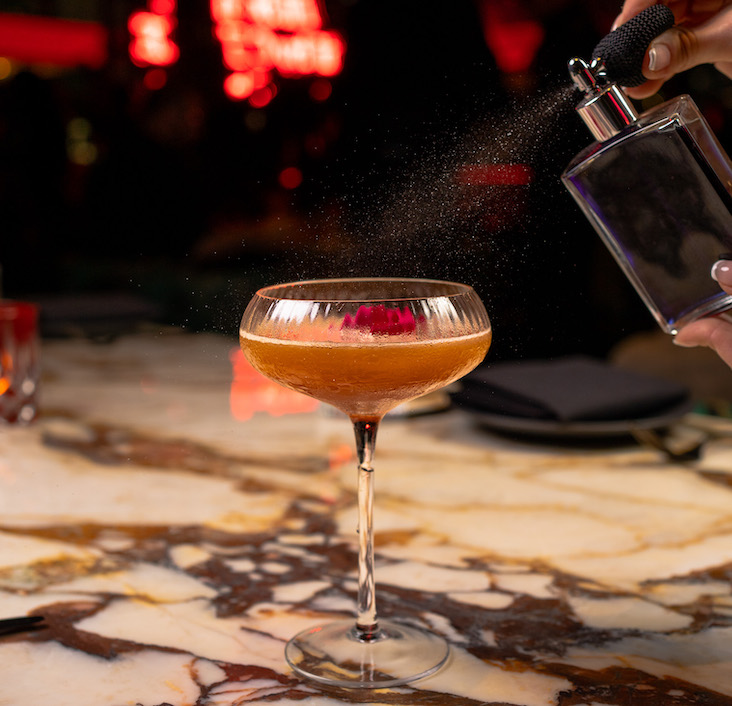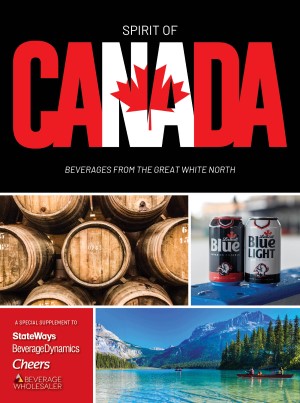CZAR VODKA
Flavored, on the rocks, frozen shots, alternatinis or just mixed –VODKA RULES.
by Jack Robertiello
photography by Dan Kozan
Its origins may be in dispute, but no one can argue over the raw data; despite a slight fall off last year, vodka dominates the spirits world, accounting for about 23% of the entire category in 1997, according to Adams Business Media Handbook Advance 1998.
While the Poles and the Russians may lay claim to creating this neutral-grain spirit, it’s now a full-fledged member of the international family, representing on its own a sort of United Nations of spirits. New brands are joining all the time, not only from eastern Europe, the Baltic and Scandinavia, but even France and Italy. Vodka may derive its name from Russian for water (vodka), but today, it’s a beverage as international as Coke.
The latest vodka wave began in the early ’90s when such high-profile products as the U.S.-produced Skyy and the Dutch Ketel One emerged, soon to be followed into the marketplace by France’s Grey Goose and Poland’s Belvedere and Chopin. The success of these vodkas, joining the well-known powerhouses Absolut, Finlandia, Stolichnaya and their flavored line extensions, simply indicated the spirit’s firm entrenchment as THE alcohol of choice in the contemporary cocktail.
Marketers keep working on new product wrinkles to squeeze more out of the superpremium vodka niche. Rain, distilled and marketed by Sazerac, is touted as the first vodka made exclusively from organically-grown grain. Canadian Iceberg, distributed in the U.S. by 21 Brands, a division of Remy Amerique, claims to come from 12,000-year-old, you guessed it, icebergs.
But what are bartenders and beverage managers DOING with all these varieties? Except for the flavored varieties, most vodkas are difficult to sell strictly based on their individual flavor and aroma. Instead, operators are relying on the spirit’s mixability, the very characteristic that broke vodka into the mainstream in the 1960s with Bloody Marys, Moscow Mules and Screwdrivers.
However, today’s drinker seeks more sophistication, creativity and showmanship. Obliging them–and charging a healthy premium–are such trend-setting spots as Manhattan’s popular Gramercy Tavern, where the bar area is often more crowded than its reservation book. One of the favorites there is the Rosmarino, a pale ale-shaded cocktail made from rosemary-infused vodka, Pernod and dry vermouth and served up, with a trio of salty capers gathered at the bottom of the glass.
Leave it to a restaurant competing for attention in ultra-trendy Miami Beach for the latest in vodka trends. Red Square, one of New York-based Jeffrey Chodorow’s China Grill operations, is a magnified fantasy of Russia. With about 90 bottled vodkas and nine or so house infused varieties–including kiwi-strawberry, mango-lemon grass and rosemary-roasted garlic–Red Square is a vodka-centric emporium of frozen spirits and caviar.
“We have made a major commitment to vodka here,” says general manager Parnell Delcham. “The whole theme behind our bar is to be the most extensive vodka bar in Florida because of its connection to Russia.” With only about 40 of the vodkas they sought available from local distributors, Red Square gathered the rest by calling in favors, working the internet and getting liquor suppliers to work outside traditional distribution channels.
Like New York’s Pravda, which made a splash in 1996 with a mix of Russian deconstructionist art, caviar and vodka, Red Square creates a pseudo-Soviet atmosphere. But they have created a bartop that is a slab of frozen ice, cooled much like an indoor skating rink. It helps keep those frozen vodkas cold, Delcham says.
The vodkas and glassware are also frigid, kept at 30 degrees below zero in a 2,000 pound refrigerated wall unit that’s as much display piece as functional freezer. “We sell lots of frozen shots,” says Delcham. “We work at getting people to order some of our specialty vodkas, like Baik from Siberia. We have the only 50 cases in America.”
But Red Square’s signature cocktails, creations of Chodorow based on drinks he discovered during his travels, are as much a part of Red Square’s attraction as the frozen vodkas. The most popular, says Delcham, is the Blue Cossack, a blend of Stoli Ohranj, blue curacao, Cointreau, lime juice and pineapple juice. Also big sellers are the Red Square–Stoli Pertsovka, Stoli and a splash of sweet vermouth and the Kempinsky Fizz, a mix of vodka, creme de cassis, lime juice and ginger ale.
Oddly, the most popular vodkas at Red Square are neither Russian, Polish, nor Scandinavian; instead, it’s a pair of Italian invaders, Arctic Melon and Kegelvich Coconut. Altogether, Red Square carries 21 Russian, 15 Italian, 8 Polish, 10 U.S. and five Swedish varieties, along with odd lots from Israel, Japan and Jamaica. And while the new and unusual are making a splash, Red Square also carries the usual powerhouse suspects: Stoli, Absolut, Finlandia, Ketel One, Grey Goose, Belvedere, Wyborowa, Tanqueray Sterling, Skyy and Smirnoff.
Chuck Przybylinski, co-owner of Chicago’s Wonton Club, has built a drink menu primarily around vodka, perhaps unusual for a restaurant with an Asian-inspired menu. “For people who don’t have a favorite cocktail already, drinks based on vodka give us an opportunity to add all the bells and whistles, which you can’t really do for someone who wants, say, a perfect Manhattan,” he says. Women, especially, are ordering Wonton Club’s signature vodka drinks, he says, mainly as their single beverage choice of the evening to be sipped over the course of appetizers and the meal.
It’s vodka’s clean taste, as opposed to gin’s juniper flavor, that explains why flavored gins and other strongly flavored spirits-based beverages don’t have broad appeal with today’s consumers, he says.
Wonton Club’s spicy/sweet pan-Asian food is perfect for the kind of no-holds-barred experimentation that today’s cocktail drinker welcomes. The food there shares the spotlight with an array of vodka-based drinks, including the Island, made from coconut-infused vodka with lime juice; the Pearl, a mix of Absolut with pear sake; the Rising Sun, made from Stoli Ohrahnj and Cointreau; Lowtide, a blend of coconut-infused vodka, creme de cacao and cream; and the Sunset, made with Ketel One vodka mixed with Midori melon liqueur and orange juice.
“Who knows, maybe people will get tired of all these vodka drinks one day, and we’ll be stuck with infusers and everything,” Przybylinski adds. But he doesn’t sound like he believes it, and few observers really expect the onslaught of new flavors, recipes and national styles of vodka to abate anytime soon.
Karl Rigelman, general manager of the two-unit Minneapolis-St. Paul-based Table of Contents, says it’s easy to understand why so many new vodkas are entering the fray. Vodka is the cheapest spirit to make, and there’s a great deal of profit to be made from it; it was only a matter of time before companies started pouring money into building that business.”
“We’ve taken great liberties with the Martini here,” says Rigelman. As a result of creative bartenders and operators such as Rigelman developing signature drinks, vodka may be rewriting the bartender’s recipe book entirely.
Rigelman’s beverage list includes at least one consisting mainly of house-infused vodka–the Legal Herb, basil-infused vodka and dry vermouth mixed in Martini proportions served with a lemon twist. There’s also the Kafini, made from Stoli coffee vodka with a splash of Frangelico, and the beverage menu even lists a separate category for their BFM’s–Big Funky Martinis, which include the Summertini–citrus vodka shaken with Midori and sweetened lemon juice; and the Citronella, citrus vodka shaken with cranberry juice, lemon juice and lime juice. In fact, the first thing guests see upon entering the restaurants are a table with a trio of chilled Martini glasses.
“We will continue to add quality vodkas, but there are a lot of garbage vodkas in fancy labels out there, too,” Rigelman says. But he credits such marketers as the Millennium Import Company for savvy marketing of their Belvedere and Chopin brands. “Brilliant packaging and marketing and a very good product.”
Other places are turning the Martini-style cocktail into a cult. At the Peabody in Memphis, tableside preparation has become the latest service wrinkle. Using Grey Goose as a base, the Peabody’s waitstaff whips up such Martini variations as the French Kiss, a mix of vodka, champagne and a strawberry, and le Martini Cerises, vodka with a misting of vermouth and vodka-soaked cherries. And misting is exactly what they mean; the tableside preparation includes not only a silver service tray but also an atomizer filled with vermouth.
Table of Contents, after some experimenting, is sticking to its basil infusion for now, but other operators like to fiddle with their own creations. At Allegria in New York, the key ingredient in their Bloody Mary is Finlandia infused with sun-dried tomatoes, lemons, chiles and horseradish. Others are experimenting with such things as Finlandia’s fruit infusion program. But whether an operator is sticking to vodka and fruit juice libations or working the new Martini, there’s still room for growth–and profit–in the category.




